The Black-Naped Oriole (Oriolus chinensis) stands as a captivating symbol of tropical biodiversity, renowned for its vibrant plumage, melodious calls, and ecological importance across Southeast Asia.
With its striking golden-yellow feathers accented by contrasting black markings, this bird species captures the imagination of bird enthusiasts and casual observers alike.
Beyond its aesthetic appeal, the Black-Naped Oriole plays a vital role in its ecosystem as a seed disperser, insect predator, and pollinator of flowering plants.
Its adaptability to diverse habitats, including forests, urban areas, and suburban gardens, reflects its resilience to environmental change.
As we delve into the fascinating world of the Black-Naped Oriole, we uncover its biological significance and cultural and ecological contributions to the rich tapestry of Southeast Asian biodiversity.
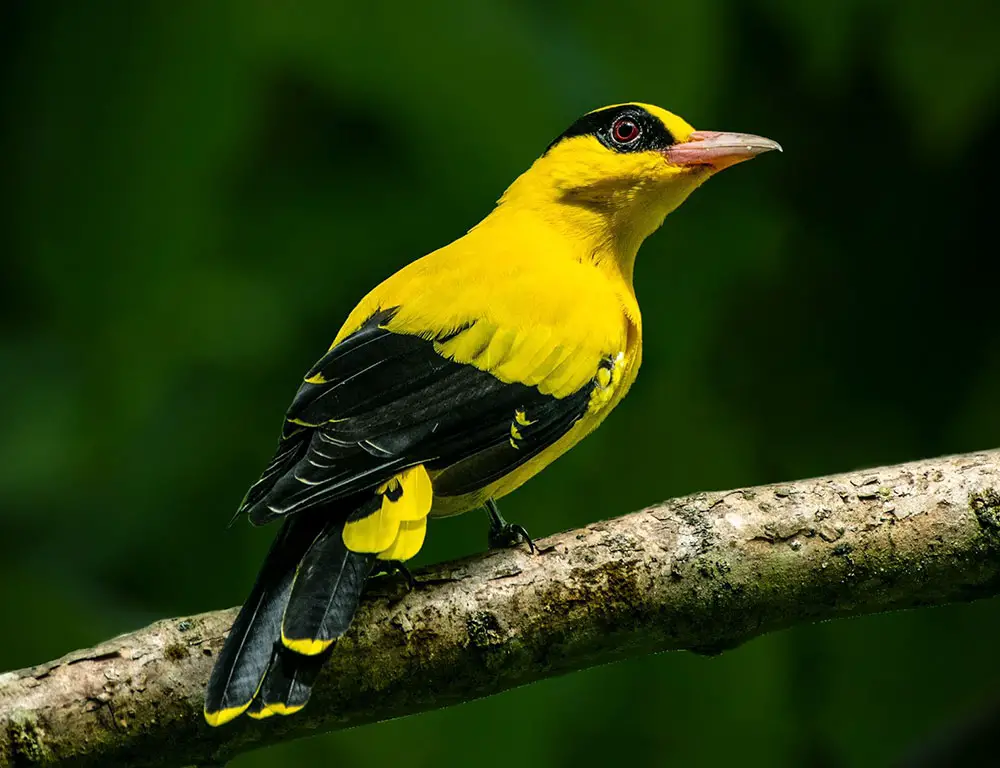
Some Common Characteristics Of Black-Naped Oriole
The Black-Naped Oriole (Oriolus chinensis) is a captivating bird species in Southeast Asia, renowned for its vibrant plumage and melodious calls. Here are some common characteristics of this species:
Physical Characteristics Of Black-Naped Oriole
The Black-Naped Oriole (Oriolus chinensis) is a striking bird species in Southeast Asia, known for its vibrant plumage and melodious calls. Here are seven physical characteristics that distinguish this species:
Plumage
The Black-Naped Oriole exhibits a striking contrast of colors with its predominantly golden-yellow plumage. Its wings and tail are adorned with black markings, while a distinctive black stripe runs from its nape to its upper back, giving it its name.
Size
This species typically measures around 25 to 30 centimeters in length, with a wingspan ranging from 30 to 35 centimeters. Its slender body and long tail feathers contribute to its graceful appearance.
Bill
The Black-Naped Oriole boasts a slender, slightly curved bill adapted for capturing insects and probing flowers for nectar. Its bill is primarily black, contrasting beautifully against its bright plumage.
Eyes
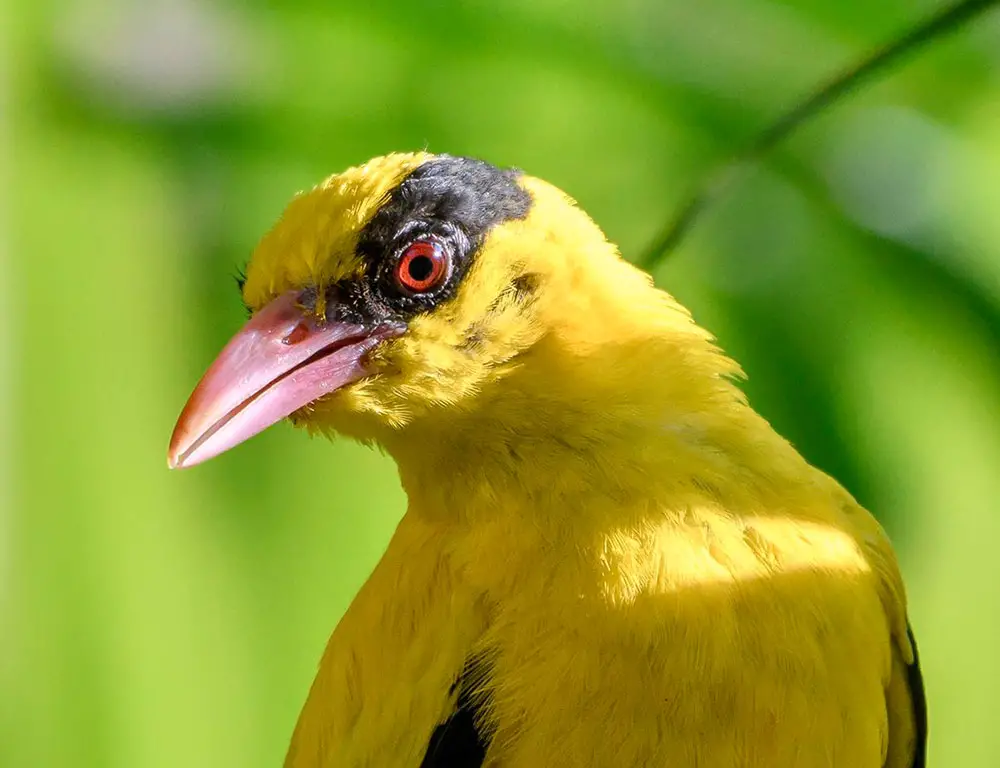
Its eyes are large and round, positioned on either side of its head, providing excellent binocular vision. The iris is typically a deep reddish-brown, adding to its striking appearance.
Legs and Feet
The legs of the Black-Naped Oriole are relatively short but sturdy, adapted for perching and hopping among branches. Its feet are equipped with sharp claws, aiding in grasping onto branches and securing prey.
Crest
One of the most distinctive features of this bird is its prominent crest, which can raise or lower depending on its mood or level of alertness. When excited or alarmed, the crest stands erect, adding to its overall elegance.
Tail
The long, graceful tail of the Black-Naped Oriole is another distinguishing characteristic. It is often held downward while perched but becomes more conspicuous during flight, with its black and yellow markings creating a striking visual display.
Distribution And Habitat
Black-naped Orioles inhabit various forested habitats, including tropical and subtropical forests and wooded areas near human settlements.
They are commonly found in India, Indonesia, Malaysia, and the Philippines, where they thrive in diverse ecosystems ranging from lowlands to mountainous regions.
Behavior And Ecology
These orioles are known for their acrobatic flight patterns and melodious vocalizations, which include a variety of whistles, trills, and mimicry of other bird species.
They are primarily insectivorous, foraging among tree canopies for insects, fruits, and nectar, often displaying agility as they capture prey mid-flight or glean from foliage.
Threats
Despite their widespread distribution, Black-Naped Orioles face threats from habitat loss due to deforestation, urbanization, and agricultural expansion. Additionally, they may be susceptible to illegal trapping for the pet trade in some regions.
Conservation
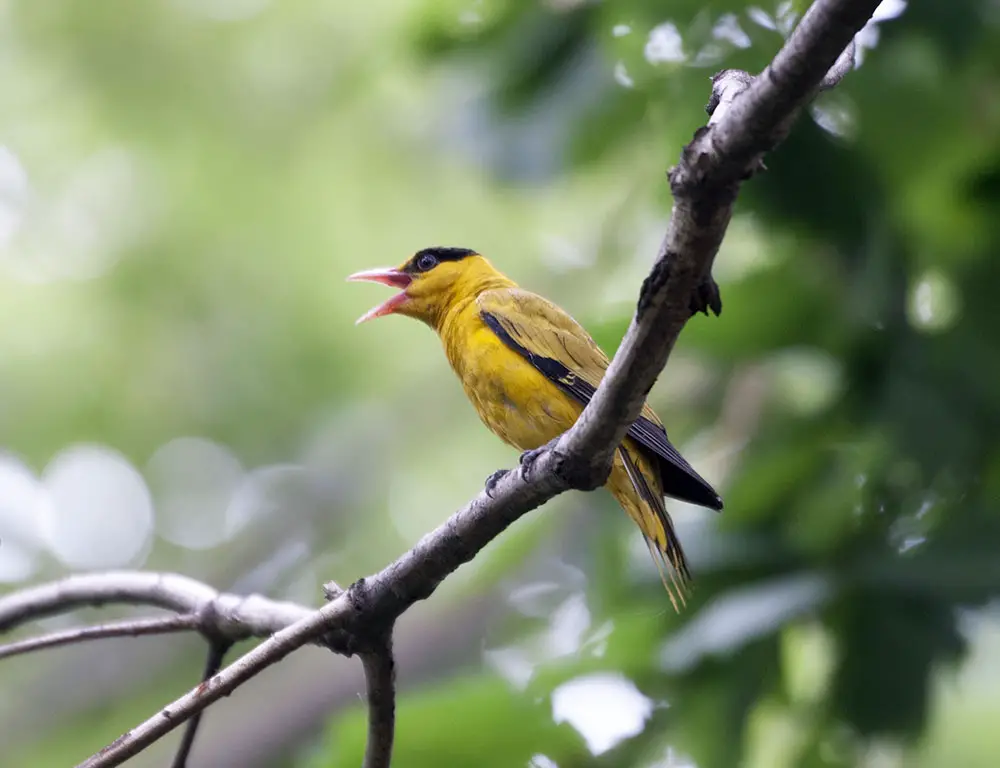
Conservation efforts aimed at protecting the natural habitats of Black-Naped Orioles are crucial for their long-term survival.
Establishing and managing protected areas, promoting sustainable land-use practices, and raising awareness about the importance of biodiversity conservation are essential steps in safeguarding this species.
Evolution
The Black-Naped Oriole belongs to the family Oriolidae, which includes diverse species of orioles across the Old World.
Evolutionary studies suggest that orioles diverged from other songbird lineages millions of years ago, adapting to various ecological niches and environmental conditions.
Reproduction
During the breeding season, typically from March to July, Black-Naped Orioles form monogamous pairs and build cup-shaped nests suspended from tree branches.
The female lays a clutch of 2-4 eggs, which are incubated for about two weeks before hatching. Both parents participate in feeding and caring for the chicks until they fledge.
Food
Black-naped Orioles primarily feed on a diet of insects, including beetles, caterpillars, and grasshoppers, which they catch in mid-air or glean from foliage.
They also consume fruits, berries, and nectar, contributing to seed dispersal and pollination in their ecosystem.
The Black-Naped Oriole exhibits various common characteristics that reflect its adaptability, ecological importance, and vulnerability to human-induced threats.
Conservation efforts aimed at preserving its natural habitat and addressing key challenges are essential for ensuring the continued survival of this iconic bird species.
Taxonomy
Here’s a simplified table outlining the taxonomy and systematics of the Black-Naped Oriole (Oriolus chinensis):
| Kingdom | Animalia |
| Phylum | Chordata |
| Class | Aves |
| Order | Passeriformes |
| Family | Oriolidae |
| Genus | Oriolus |
| Species | Oriolus chinensis |
The Black-Naped Oriole belongs to the Animalia kingdom, Chordata phylum, Aves class, Passeriformes order, Oriolidae family, Oriolus genus, and its specific species name is Oriolus chinensis.
This classification reflects its evolutionary relationships and taxonomic placement among other bird species.
Nesting Habit Of Black-Naped Oriole
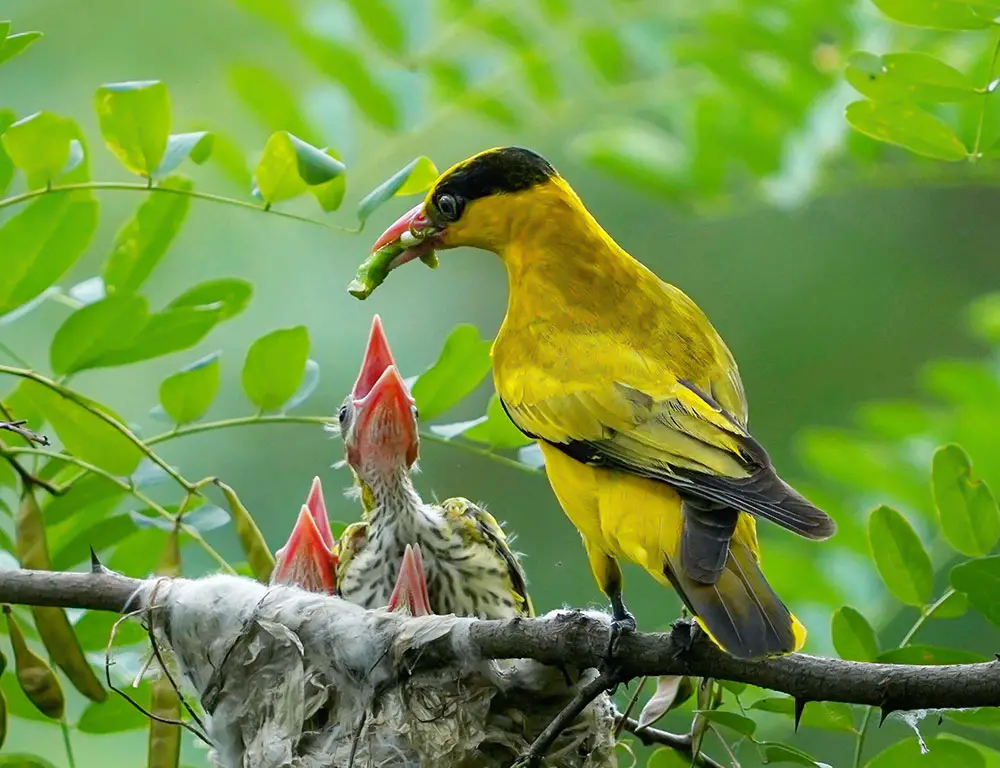
Here’s a simplified table outlining the nesting habits of the Black-Naped Oriole:
| Nesting Habit | Description |
| Nest Type | Cup-shaped nest suspended from tree branches |
| Nest Material | Constructed using grass, plant fibers, and spider silk |
| Nest Placement | Typically located in the canopy of trees |
| Breeding Season | Occurs during March to July |
| Clutch Size | Typically consists of 2-4 eggs |
| Incubation Period | Eggs are incubated for about two weeks by both parents |
| Parental Care | Both male and female participate in nest building, incubation, and feeding of the young chicks until they fledge |
| Fledging | Chicks fledge approximately 14-20 days after hatching |
This table provides an overview of the nesting habits of the Black-Naped Oriole, including nest type, material, placement, breeding season, clutch size, incubation period, parental care, and fledging.
These nesting behaviors reflect the species’ reproductive strategies and adaptation to its natural habitat.
Ranging Map Of Black-Naped Oriole
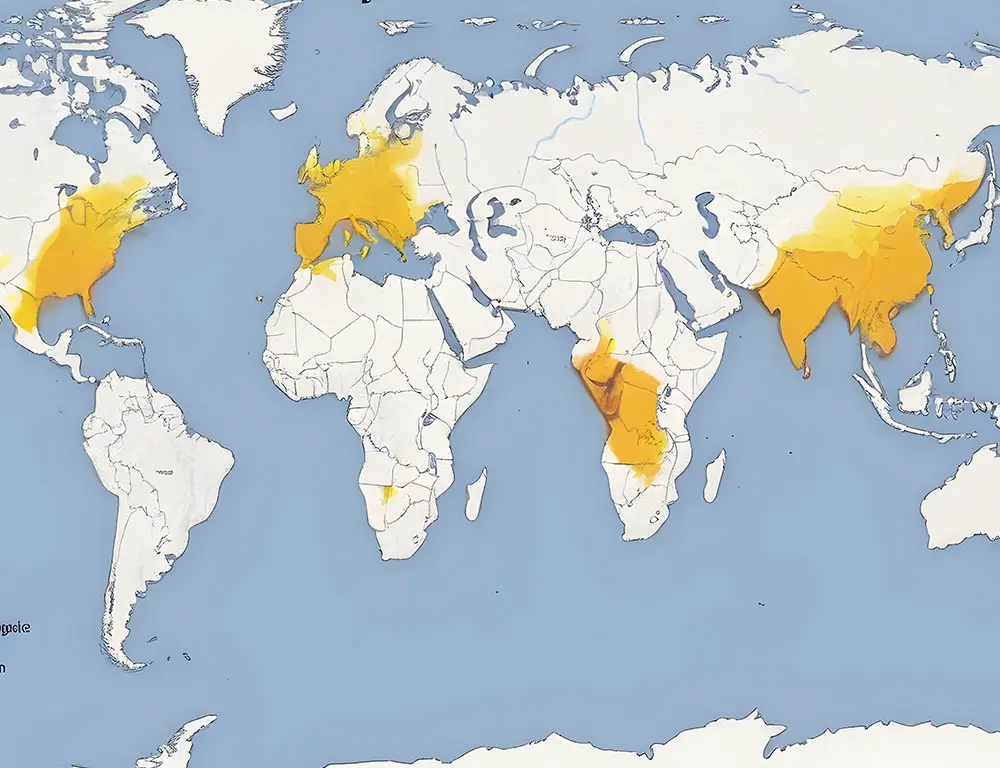
The ranging map of the Black-Naped Oriole (Oriolus chinensis) depicts the distribution of this bird species across its natural habitat in Southeast Asia. Here are the details regarding its ranging map:
Geographic Range
The Black-Naped Oriole is native to a wide geographical range across Southeast Asia.
Its distribution encompasses countries such as India, Bangladesh, Myanmar, Thailand, Laos, Cambodia, Vietnam, Malaysia, Singapore, Indonesia (including Sumatra, Java, Borneo, and other islands), the Philippines, and southern China.
Habitat Preferences
Within its range, the Black-Naped Oriole occupies various habitats, including tropical and subtropical forests, secondary growth, woodland edges, parks, gardens, and rural areas with scattered trees.
It is widespread in lowland regions but can also be found at higher elevations in mountainous areas.
Altitudinal Range
While the Black-Naped Oriole is primarily a lowland species, it can be found at varying altitudes depending on the local topography and habitat availability.
In some regions, it may occur from sea level up to elevations of around 2,000 meters (6,500 feet) or more in mountainous terrain.
Seasonal Movements
The Black-Naped Oriole is primarily a resident bird, meaning it typically does not undertake long-distance seasonal migrations.
However, some populations may exhibit localized movements in response to changes in food availability, breeding behavior, or habitat conditions.
Range Extensions
Occasionally, sightings of Black-Naped Orioles may occur outside their typical range, either due to natural dispersal events or human-induced factors such as habitat alteration or accidental introductions. However, such occurrences are relatively rare and usually limited in scope.
Conservation Status
While the Black-Naped Oriole is not currently considered globally threatened, populations in certain regions may face localized threats from habitat loss, degradation, and fragmentation.
Conservation efforts aimed at protecting key habitats, implementing sustainable land-use practices, and raising awareness about the importance of biodiversity conservation are essential for ensuring the long-term survival of this species.
Overall, the ranging map of the Black-Naped Oriole illustrates its widespread distribution across Southeast Asia and highlights the importance of conserving diverse habitats to maintain healthy populations of this iconic bird species.
What Does Black-Naped Oriole Eat?
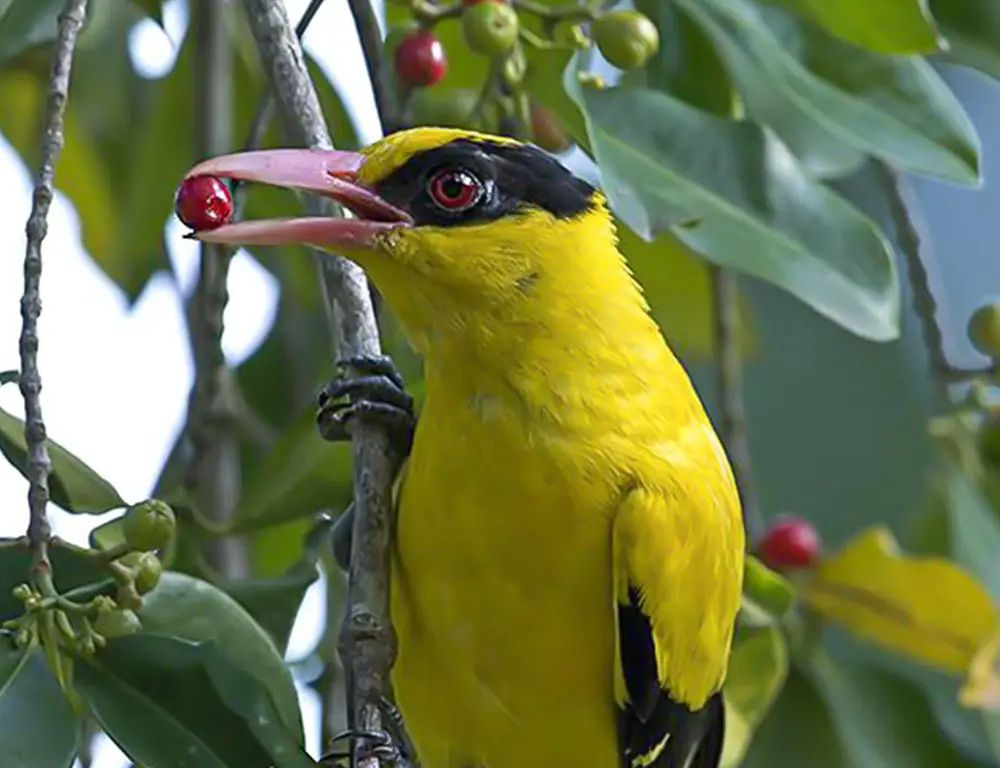
The Black-Naped Oriole (Oriolus chinensis) is an omnivorous bird species with a diverse diet, enabling it to adapt to various habitats and food sources across Southeast Asia.
Here are seven things that the Black-Naped Oriole commonly eats:
Insects
Insects constitute a significant portion of the Black-Naped Oriole’s diet, with the bird feeding on a wide variety of invertebrates such as beetles, caterpillars, grasshoppers, crickets, and ants.
It employs various foraging techniques, including gleaning insects from foliage, catching them mid-flight, or probing crevices for hidden prey.
Fruits
Fruits and berries are another critical component of the Black-Naped Oriole’s diet, particularly during the non-breeding season when insects may be less abundant.
It consumes various fruits, including figs, berries, small fruits, and even cultivated fruits like bananas and papayas. By feeding on fruits, the bird contributes to seed dispersal and helps maintain plant diversity in its habitat.
Nectar
The Black-Naped Oriole is known to supplement its diet with nectar, especially from flowers with tubular or bell-shaped blooms. It uses its slender bill to probe deep into flowers, extracting nectar as a source of energy.
This behavior provides nutrition for the bird and facilitates pollination of flowering plants.
Seeds
While not a primary food source, the Black-Naped Oriole may occasionally consume seeds and grains, particularly during scarcity or as supplementary food.
It may forage on the ground or glean seeds from grasses and plants, although seeds typically comprise a smaller portion of its diet than insects and fruits.
Small Reptiles And Amphibians
Although less common, the Black-Naped Oriole may opportunistically feed on small reptiles such as lizards and amphibians like frogs and tadpoles.
It may capture these prey items while foraging in the forest understory or near bodies of water, adding to the bird’s dietary diversity.
Small Mammals
While relatively rare, Black-Naped Orioles have been observed feeding on small mammals such as rodents and shrews on occasion.
These instances may occur when the opportunity presents itself, such as encountering injured or weakened individuals, but such prey items are not a significant component of their diet.
Human-Provided Food
In urban and suburban areas, Black-Naped Orioles may also consume human-provided food items such as bread crumbs, rice, or leftover fruits.
While these offerings are not natural components of their diet, they may supplement the bird’s nutrition, especially in environments with limited natural food sources.
The Black-Naped Oriole exhibits a versatile diet that includes insects, fruits, nectar, seeds, and occasionally small vertebrates, reflecting its adaptability to various habitats and foraging strategies.
This dietary flexibility contributes to the bird’s survival and ecological importance across its range in Southeast Asia.
10 Interesting Facts About Black-Naped Oriole
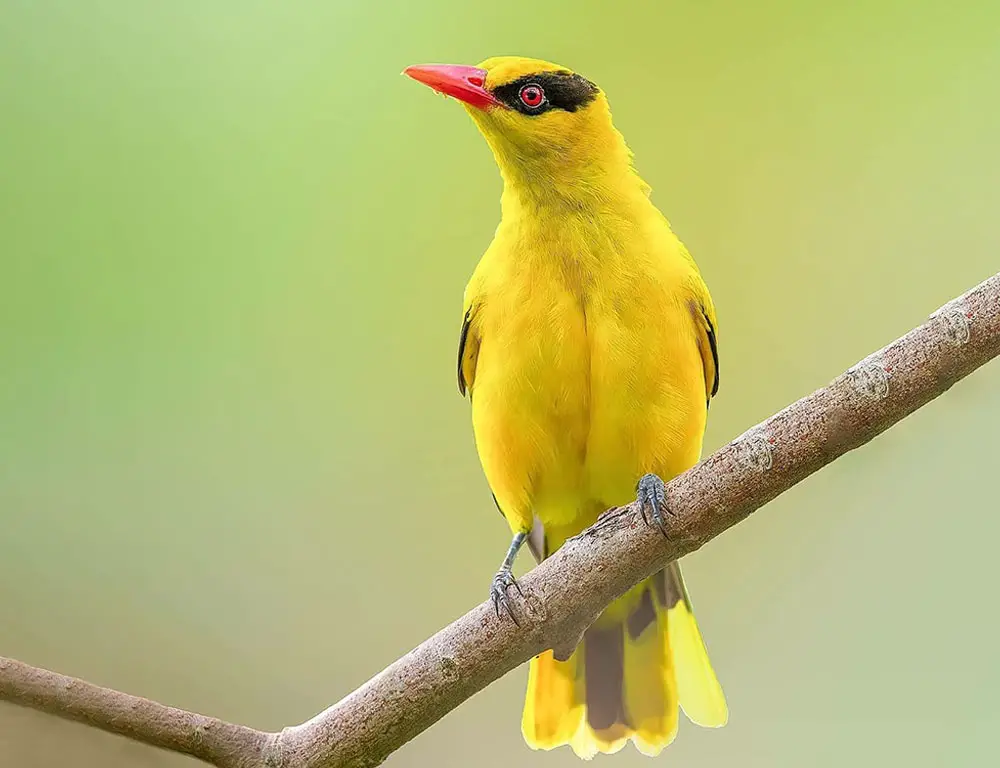
Here are 10 interesting facts about the Black-Naped Oriole:
1. Vibrant Plumage
The Black-Naped Oriole is renowned for its striking appearance, characterized by vibrant golden-yellow plumage contrasted with black markings on its wings, tail, and nape.
2. Melodious Calls
These orioles are talented vocalists, producing a variety of musical calls, including whistles, trills, and mimicry of other bird species, adding to the ambiance of their tropical habitats.
3. Range Across Southeast Asia
The Black-Naped Oriole is native to a wide geographical range across Southeast Asia, including India, Indonesia, Malaysia, the Philippines, and southern China.
4. Nesting Behavior
During the breeding season, Black-Naped Orioles construct intricate cup-shaped nests suspended from tree branches using materials such as grass, plant fibers, and spider silk, demonstrating impressive architectural skills.
5. Monogamous Pairs
These birds typically form monogamous pairs during the breeding season, with both the male and female participating in nest building, incubation, and feeding of the young.
6. Agile Flyers
Black-naped Orioles exhibit agile flight patterns, darting among tree canopies with grace and precision as they forage for insects or move between feeding sites.
7. Urban Adaptability
While primarily found in forested habitats, Black-Naped Orioles are also known to inhabit urban and suburban areas, where they may nest in parks, gardens, and wooded neighborhoods.
8. Seed Dispersers
By consuming various fruits, Black-Naped Orioles play a role in seed dispersal, helping maintain plant diversity and ecosystem health in their habitats.
9. Cultural Significance
In some cultures, the presence of Black-Naped Orioles is considered auspicious, with their musical calls symbolizing joy, prosperity, and good fortune.
10. Conservation Concerns
While not currently considered globally threatened, Black-Naped Orioles may face localized threats from habitat loss, deforestation, and illegal trapping for the pet trade, highlighting the importance of conservation efforts to safeguard their populations.
These fascinating facts shed light on the beauty, ecological importance, and cultural significance of the Black-Naped Oriole across Southeast Asia.
Conclusion
The Black-Naped Oriole emerges as a charismatic ambassador of Southeast Asian avifauna, captivating hearts with its beauty and enriching ecosystems with its ecological roles.
As we strive to conserve the natural habitats that support this iconic bird species, we also acknowledge the importance of raising awareness about its conservation needs and fostering appreciation for its cultural significance.
By safeguarding the habitats and promoting sustainable practices that benefit the Black-Naped Oriole, we contribute to the broader conservation efforts aimed at preserving biodiversity and maintaining the delicate balance of nature in the dynamic landscapes of Southeast Asia.
Let us cherish the presence of the Black-Naped Oriole as a symbol of resilience, beauty, and interconnectedness in our natural world.